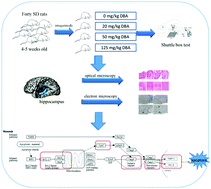当前位置:
X-MOL 学术
›
Mol. Biosyst.
›
论文详情
Our official English website, www.x-mol.net, welcomes your
feedback! (Note: you will need to create a separate account there.)
DBA-induced caspase-3-dependent apoptosis occurs through mitochondrial translocation of cyt-c in the rat hippocampus
Molecular BioSystems Pub Date : 2017-07-05 00:00:00 , DOI: 10.1039/c7mb00246g Wenbo Jiang 1, 2, 3, 4, 5 , Yingying Chen 1, 2, 3, 4, 5 , Bai Li 1, 2, 3, 4, 5 , Shuying Gao 1, 2, 3, 4, 5
Molecular BioSystems Pub Date : 2017-07-05 00:00:00 , DOI: 10.1039/c7mb00246g Wenbo Jiang 1, 2, 3, 4, 5 , Yingying Chen 1, 2, 3, 4, 5 , Bai Li 1, 2, 3, 4, 5 , Shuying Gao 1, 2, 3, 4, 5
Affiliation

|
Dibromoacetic acid (DBA), a by-product of disinfection, develops in drinking water during chlorination or ozonation processes. Water intake is the main source of DBA exposure in humans, which is potentially neurotoxic. The present study investigated the neurotoxic effects of DBA by assessing the behavioral and biochemical characteristics of Sprague Dawley rats intragastrically treated with DBA at concentrations of 20, 50 and 125 mg kg−1 body weight for 28 consecutive days. The results indicated that animal weight gain and food consumption were not significantly affected by DBA. However, shuttle box tests showed increases in mistake frequency and reaction latency between the control and high-dose group. We found significant changes in hippocampal neurons by histomorphological observation. Additionally, biochemical analysis indicated enhanced production of reactive oxygen species (ROS) resulting in disruption of cellular antioxidant defense systems including decreased mitochondrial superoxide dismutase (SOD) activity and release of cytochrome c (cyt-c) from mitochondria into the cytosol, which can induce neuronal apoptosis. Furthermore, the increase of cyt-c in the cytosol enhanced caspase-3 and caspase-9 activity, which was confirmed by poly ADP-ribose polymerase-1 (PARP-1) cleavage to its signature fragment of 85 kDa and decreased levels of protein kinase C-δ (PKC-δ) in the hippocampus. Meanwhile, DBA treatment caused differential modulation of apoptosis-associated proteins and mRNAs for phosphorylated apoptosis signal regulating kinase 1 (p-ASK-1), phosphorylated c-jun N-terminal kinase (p-JNK), cyt-c, Bax, Bcl-2, caspase-9 and cleaved caspase-3 accompanied by DNA damage. Taken together, these data indicate that DBA may induce neurotoxicity via caspase-3-dependent apoptosis involving mitochondrial translocation of cyt-c in the rat hippocampus.
中文翻译:

DBA诱导的caspase-3依赖性凋亡通过大鼠海马中cyt- c的线粒体易位而发生
消毒的副产品二溴乙酸(DBA)在氯化或臭氧化过程中会在饮用水中形成。摄入水是人类接触DBA的主要来源,这可能具有神经毒性。本研究通过评估浓度为20、50和125 mg kg -1的DBA胃内处理的Sprague Dawley大鼠的行为和生化特征,研究了DBA的神经毒性作用体重连续28天。结果表明,DBA对动物增重和食物消耗没有显着影响。但是,穿梭箱测试显示,对照组和高剂量组之间的错误频率和反应潜伏期增加。通过组织形态学观察,我们发现海马神经元发生了显着变化。此外,生化分析表明,活性氧(ROS)的产生增加,导致细胞抗氧化剂防御系统的破坏,包括线粒体超氧化物歧化酶(SOD)活性降低以及细胞色素c(cyt- c)从线粒体释放到细胞质中,这可以诱导神经元凋亡。此外,CYT-的增加Ç胞浆中的Caspase-3和caspase-9活性增强,这可以通过聚ADP-核糖聚合酶-1(PARP-1)裂解为其特征片段85 kDa以及降低蛋白激酶C-δ(PKC-δ)来证实)在海马中。同时,DBA处理引起细胞凋亡相关蛋白和mRNA的差异调节,磷酸化细胞凋亡信号调节激酶1(p-ASK-1),磷酸化c-jun N-末端激酶(p-JNK),cyt- c,Bax,Bcl -2,caspase-9和裂解的caspase-3伴有DNA损伤。综上所述,这些数据表明DBA可能通过caspase-3依赖性细胞凋亡(包括大鼠海马中cyt- c的线粒体易位)诱导神经毒性。
更新日期:2017-08-22
中文翻译:

DBA诱导的caspase-3依赖性凋亡通过大鼠海马中cyt- c的线粒体易位而发生
消毒的副产品二溴乙酸(DBA)在氯化或臭氧化过程中会在饮用水中形成。摄入水是人类接触DBA的主要来源,这可能具有神经毒性。本研究通过评估浓度为20、50和125 mg kg -1的DBA胃内处理的Sprague Dawley大鼠的行为和生化特征,研究了DBA的神经毒性作用体重连续28天。结果表明,DBA对动物增重和食物消耗没有显着影响。但是,穿梭箱测试显示,对照组和高剂量组之间的错误频率和反应潜伏期增加。通过组织形态学观察,我们发现海马神经元发生了显着变化。此外,生化分析表明,活性氧(ROS)的产生增加,导致细胞抗氧化剂防御系统的破坏,包括线粒体超氧化物歧化酶(SOD)活性降低以及细胞色素c(cyt- c)从线粒体释放到细胞质中,这可以诱导神经元凋亡。此外,CYT-的增加Ç胞浆中的Caspase-3和caspase-9活性增强,这可以通过聚ADP-核糖聚合酶-1(PARP-1)裂解为其特征片段85 kDa以及降低蛋白激酶C-δ(PKC-δ)来证实)在海马中。同时,DBA处理引起细胞凋亡相关蛋白和mRNA的差异调节,磷酸化细胞凋亡信号调节激酶1(p-ASK-1),磷酸化c-jun N-末端激酶(p-JNK),cyt- c,Bax,Bcl -2,caspase-9和裂解的caspase-3伴有DNA损伤。综上所述,这些数据表明DBA可能通过caspase-3依赖性细胞凋亡(包括大鼠海马中cyt- c的线粒体易位)诱导神经毒性。











































 京公网安备 11010802027423号
京公网安备 11010802027423号